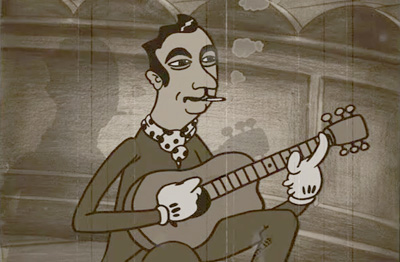

Django Reinhardt page, with a drawing of his hand and a link to a 1-minute clip from Blue Dragredhotjazz.com on Django (Joseph Dinkins)
RF Charle page on Selmer guitars (in French) --see plans for both common styles, and x-ray
It's interesting to consider the long-run influence of a single musician, and Django makes a good case for us: continuing the Gypsy thread, drawing on CDs and video resources I have, and considering written material in the library and elsewhere.
First, his name: officially Jean Reinhardt, Django was his Romany name (Dregni says it means "I awake", in his definitive biography: Django : the life and music of a Gypsy legend [Oxford University Press, 2004. ML419.R44 D74 2004]). A Manouche, born in a caravan in 1910, and into a world in which Gypsies got by however they could... Django started playing in dancehalls (bals) around age 12, and was first recorded at 18, playing banjo.
On these sides, Django played with power and assurance belying his age. When he hit on-the-beat rhythmic chords to bolster the accordionist's melody, he strummed his banjo with a psiton's punch driving the beat. But he was obviously not content with this role for long; such playing appeared to bore his youthful impetuosity and dreams of dance hall grandeur. Django seemed to be throwing down the gauntlet, challenging the accordionist to a duel over the song. Soon, he was adding a strummed half-note accent after the beat, and then, with a shake of the wrist, triple-time chords, bringing the song to full gallop, creating an undercurrent of swinging energy within the trio's sound. In the next chorus, he pattern-picked harmony behind the accordion, dropping effortlessly into tremolos on the secondary chords that built tension to deliver the song to its dénouement. (Dregni 31-32)Django encountered jazz in the mid-1920s, a time when many Black American players visited France --and brought this revolutionary sound with them:
That this was the devil's music was beyond doubt to most Parisians. From the dance hall regulars to the literati, jazz was a four-letter word, a shocking cacaphony of discord, an anarchy of music and tribal drumming fit only for the black savages who created it. The bals barred their doors against its entry into their sacred dance halls... But jazz was a siren song to Django... (Dregni 37)The Great Drama in 1928: a fire in Django's caravan, where his wife had been making celluloid flowers for a funeral. Django's left hand was badly burned, and his right leg too.
...his left hand was practically a clawed hook, the back shrunken into a knot of scars. His two small fingers were largely paralyzed, the tendons and nerves damaged, the digits a near-useless contortion of flesh. His index and middle fingers were likely stiff and difficult to control, but he could move them, And hyis thumb, which he rarely used in fretting but was all important in providing grip to the guitar neck, was unscathed.. Django had no choice but to put his faith in just his index and middle fingers... (Dregni 47)

Next big thing: Autumn 1931, meeting with Stéphane Grappelly --though they didn't play together regularly until 1934 --first, jamming behind the bandstand at Claridge's Hotel, and then at the Hot Club. From the Hot Club magazine:
One must say Django was the revelation of the soirée. He is a curious musician, with a style resembling no one else's. Yet this does not hinder the public from undertsanding him and applauding his solos. This white guitarist crafts small, strange musical phrases, bizarre constructions built according to the resources of an extraordinary fantasy; phrases that have an air like nothing else, and bear a delicacy, smoothness, and unity that leaves listeners dumbfounded... (Dregni 80)and another from 1934:
Late into morning, the telephone rang with African American singer Bricktop on the line telling Django and Stéphane to hustel down to her cabaret in Pigalle --Armstrong was there and raring to blow. It was five in the morning when they arrived. Without preamble Django took a seat alongside Armstrong. Stéphane remembered: "There was no discussion to decide what key they'd play in or what tunes they'd choose. Louis began and Django followed him in the twinking of an eye..." (Dregni 84-85)
(Lots more could be inserted... if I had time. It's a grand tale! Bits I have yet to assimilate have to do with the internal politics of the Hot Club, and what happened during WW II ...and Django's connections to the worlds of American jazz. In some senses, his greatest affinity might have been with the beebop generation [Charlie Parker, Dizzy Gillespie, etc etc], but his American host/sponsor in 1946 was Duke Ellington. Read an interesting summary here.)
Also:This extract from "The history of the guitar in jazz" by Norman Mongan sums it up pretty well:
"The quintets version of Sweet Sue recorded in 1935 has Reinhardt throwing everything at the listener : Chinese like double stops, harmonics, flashy multi-noted runs, the "Manouche" heritage present in the tremolo chords and on single strings. He throws off octaves and fast glissandi in a busy, thorough, driving style. Django had it all.
Django died, of a cerebral hemorrhage, in 1953
Following the Manouche mourning tradition of zelimós, the family moves out of the deceased's caravan, then sets it afire with all of the beloved's worldly possessions. In honor of the deceased's memory, thyey may keep a picture in a place of honor but they do not speak the person's name again. Their memory is honored in silence --on n'en parle pas. (Dregni 268)Dinah (1934) and I Got Rhythm (1949)
Blue Drag (Öberg 2003)